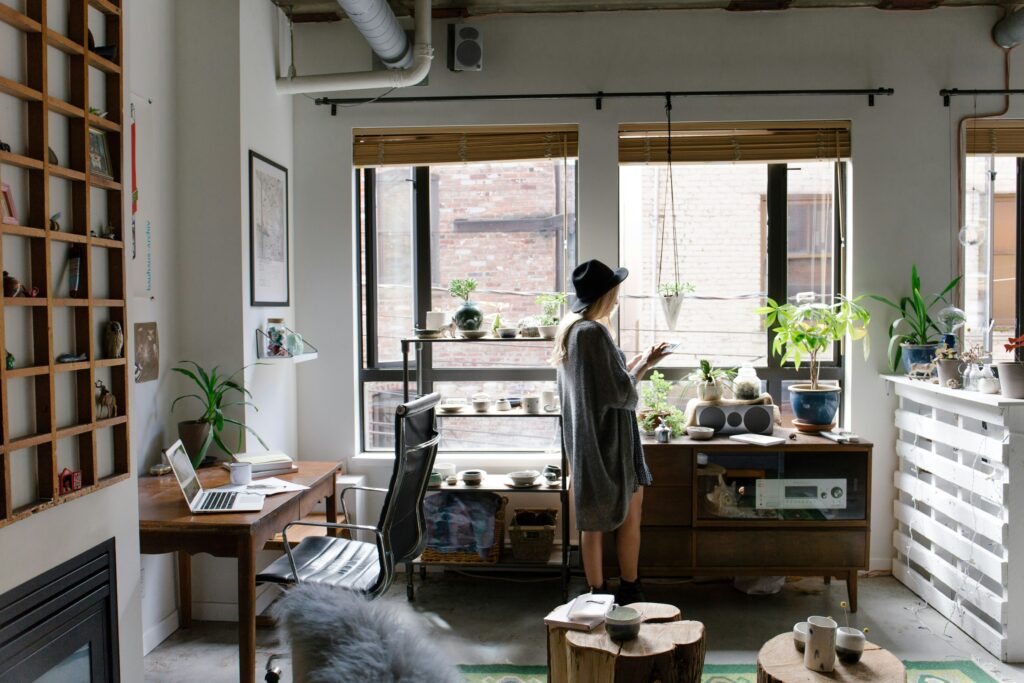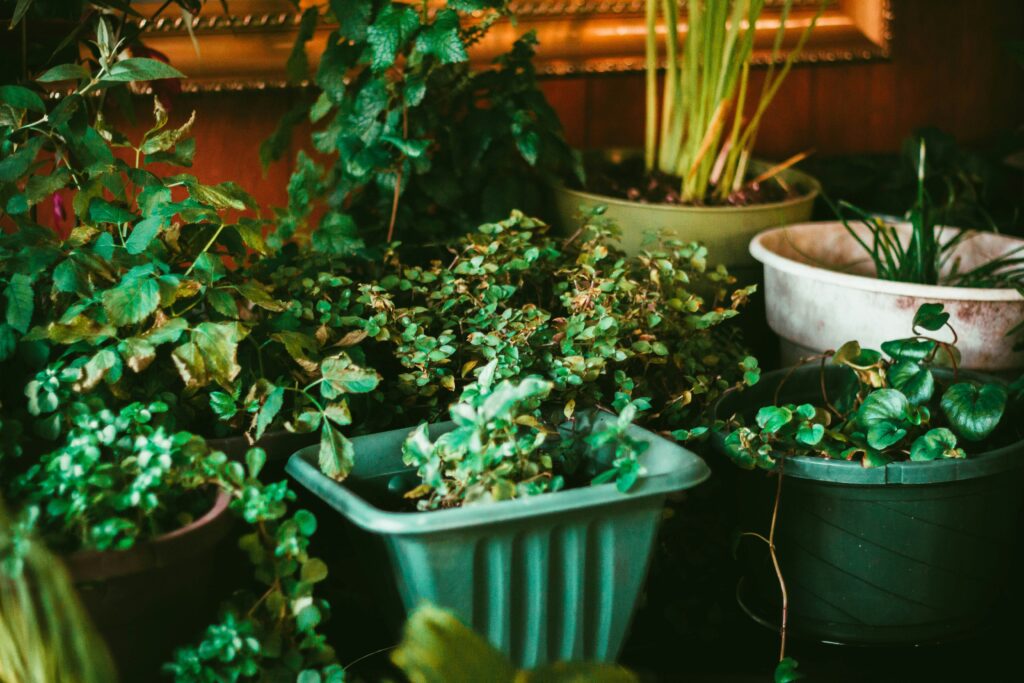No yeard no problem
If you live in a concrete jungle, make your apartment into a real jungle, or at the very least, bring some greenery inside! In your apartment, you can grow an abundance of plants, such as vibrant flowers, fresh herbs, vegetables, and houseplants. They will also provide an appealing flavor to meals and help you feel more connected to nature. Furthermore, your balcony can act as a platform for even more plant options, if you have one. All of it boils down to this: With the correct plants, supplies, and maintenance, apartment gardening is not only feasible but also incredibly simple for urbanites who have a gardening bug. Are you prepared to master apartment gardening? Continue reading to find out which plants, pots, and other items are ideal for your specific apartment setup.
INDOOR APARTMENT GARDENS:
The secret to successful apartment gardening is to work smarter, not harder. Selecting indoor plants and setting them up for success can mean the difference between lush, ambiance-lifting environments and Charlie Brown Christmas tree imitations.
Top indoor apartment garden plants:
Houseplants
There is a houseplant for almost any type of room and preference, but one of the most important considerations when choosing one is illumination. Serious lighting-loving plants will not survive in shadowy areas, and low-light lovers will find a sunny window too bright.
Dim Lighting. Grow these if you have four hours or less of direct light each day or indirect light (which is typically the case with windows facing north):
1 Pothos
2 snake
3 arrowhead vine
4 iron plants in cast iron
5 Dieffenbachia
6African violet
7 Chinese evergreen
8 peace lily
Bright Light. If your house has areas that receive a lot of sunlight, like south-facing windows that let in Bright light all day, then go for these:
1 Pine from Norfolk Island
2 dracaena
3 fiddle-leaf fig
4 spider plant
5 croton
6 jaded
7 rubber plant

Plants
There is nothing like fresh herbs to lift the mood of your kitchen or dinner. The most crucial factor to take into account when choosing plants for your indoor herb garden is illumination. You can grow almost any herb year-round if you have a grow light. If not, base your herb selection on the amount of sunlight your plants receive. Sun-loving herbs like basil and rosemary grow well in south-facing windows with lots of natural light. Herbs that tolerate some shade, like parsley, thyme, and mint, perform better in windows with less light, while they still require several hours of sun each day.
Vegetables and fruits
Choose smaller, easier-to-manage plants like lettuce, kale, and compact tomatoes for growing veggies inside. (Reserve the big males for your community garden plot or balcony.) Again, south-facing windows provide the ideal light for indoor-grown fruits and vegetables, especially sun-loving varieties like tomatoes and peppers.
Hydroponics, often known as water-based horticulture, could be the ideal answer if you want to grow fresh herbs and greens year-round in your apartment without having to get your hands dirty in the dirt. Under grow lights, hydroponic plants develop in water and consume plant food for nourishment. It produces up to 12 plants 5 times faster than dirt and is very easy to set up and maintain. Full-spectrum lighting is provided by the electronically programmable 60W LED grow lights to promote healthy plant growth. It allows all types of vegetables and herbs to grow up to 24 inches tall. In addition, you can optimize the potential for indoor growth by stacking it for vertical gardening.
The unique apartment option
The Greatest Plants for Apartments
To a certain extent, you can grow almost any plant in a container. For example, it might not be possible to place a full-size apple tree on your balcony, but there are thin columnar varieties that work well. After considering your favorite foods, select a few different plant varieties to try. Start with seeds; they are less expensive and provide greater diversity. However, you can establish your garden sooner with a few nursery plants.
Herbs: While a lot of herbs perform well in pots, they won’t get as big and bushy as they would if planted in the ground outside. However, having fresh herbs on hand for cooking is excellent. The top plants to grow in an apartment are parsley, lavender, basil, thyme, mint, and chives.
Green salad: Shallow-rooted, quickly-growing plants are popular for salads; examples are arugula, spinach, and lettuce. If they have an abundance of water, they don’t have a lot of preferences when it comes to growing conditions.
Tomatoes: Tomato plants grow nicely in pots, but they can get enormous and heavy at times. They will thrive in a container with a minimum diameter of 14 inches, but larger is preferable. The patio varieties can be grown in hanging baskets. Make sure the tomato type you select is determinate or dwarf.
Chili peppers: If you’re a fan of heat, these plants thrive in pots and can produce fruit all year. Though they usually don’t do as well as hot peppers, you can also try growing sweet peppers in containers.
Meyer lemons: Dwarf citrus trees are among the easiest fruits to grow in a container. Meyer lemons thrive inside with six to eight hours of daily sun and some humidity. Because lemon trees release sticky sap, place something underneath the pot to shield your furniture and flooring.
Strawberries: A strawberry window box is a visually stunning and delectable treat. For optimal fruit production, strawberry plants require a minimum of six hours of sunlight every day and constantly damp soil—not drenched soil.
The greatest pots for apartment indoor gardens
When choosing pots for your baby plants, take into account factors such as:
Size of plant: How big will the plant grow to its maximum size? If it outgrows its current vessel, are you willing to report it, or are you searching for a permanent home? Make sure to verify the plant tag’s mature size.
Area: What is the width of your table or windowsill? Is there room for additional items, or does the pot need to occupy the entire area? You should ask yourself questions like these!
Watering: It is a significant one. A pot that lets water drain is what you need, but not one that floods your apartment. A tray or saucer should be placed beneath each pot to collect any overflowing liquid before it hits the hardwood floors. Potted plants typically require more frequent watering than their counterparts that are planted in the ground. Every few days, insert your finger into the soil to check if the top inch is dry. If so, water the plant. Expert advice: If your plant prefers a dry environment (like a succulent), glaze pottery will probably help you reduce the amount of water it needs because terra cotta dries out more quickly than that type of pottery.
Good looks are, without a doubt, the most crucial component. You will be seeing this green companion each day after all.
Tips for Caring for Indoor Apartment Gardens
Following the selection of the ideal plant and container, there are a few important maintenance guidelines to bear in mind.
Add the appropriate ingredients to the pots. For containers, regular garden soil is too rich and heavy. A light, fluffy, premium-quality potting mix with lots of organic matter is what your potted plants need to nibble on. Proper drainage, enhanced by well-aged compost,
Give light to the world. Check the label on your plant to determine how much light it needs, then identify the best location for it in your flat. (Warning: As the seasons change, you might need to move your plants.) The most light will typically come from a southern exposure—that is, of course, given that nearby structures don’t obstruct the sun. Your plant probably needs more sun exposure if it becomes yellow and begins to drop leaves. However, if it seems dried out or has sunburned tips, it can be receiving too much light; move it away from the window.
Do not forget to stay hydrated. While some plants enjoy constant hydration, others prefer to become completely dry in between waterings. It is likely that you are not watering enough if the leaves are crispy and dry. However, limp leaves usually mean that you should cut back on the H2O.
When they’re hungry, feed them. As they grow, plants require frequent nutrient boosts, but you don’t need to fill up valuable cabinet space with an assortment of fertilizers. Utilize just one, which you may combine with water in your watering can to rapidly hydrate all of your apartment’s plant kids.
Watering: Without a doubt, watering is the most crucial gardening chore. That probably won’t be enough water for your garden, even if it gets rainy. Container soil dries out fast, especially when your plant gets bigger. Stick your finger an inch or two below the surface to test the soil.
Feeding: Depending on each plant’s unique growth requirements, you will need to feed them on a regular basis. The simplest approach is often to provide fertilizer that dissolves in water and may be added during watering. Additionally, take note of whether fertilizer is already included in your potting mix. If so, this will usually postpone your need to feed your plants.
Problems: No matter where you cultivate plants, pests, and diseases will find them. Additionally, insects have no natural predators indoors. Every time you water or harvest your plants, check them for issues. If you notice symptoms of pests or illnesses, including leaf holes or discoloration, remove that plant from the other plants until the issue is resolved.
Processing: Find out when your particular plants are ready to be harvested, and then don’t put off enjoying the results of your hard work. Harvesting can sometimes encourage a plant to grow more food for you to collect.

Good
thank you